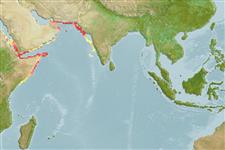>
Perciformes/Serranoidei (Groupers) >
Serranidae (Sea basses: groupers and fairy basslets)
Etymology: Chelidoperca: Greek, chelidon, -onos = swift, as black as a swift + Greek, perke = perch (Ref. 45335).
Environment: milieu / climate zone / depth range / distribution range
Ecologia
marinhas demersal; intervalo de profundidade 180 - 320 m (Ref. 124614). Tropical
Western Indian Ocean: Arabian Sea, including west coast of India, Pakistan, the Gulf of Oman, and off Socotra Island near the mouth of the Gulf of Aden.
Tamanho / Peso / Idade
Maturity: Lm ? range ? - ? cm
Max length : 12.2 cm SL macho/indeterminado; (Ref. 122102); peso máx. publicado: 3.60 g (Ref. 122102)
Found usually on continental shelf and slope muddy bottoms and caught by bottom trawl (Ref. 114767).
Ciclo de vida ou comportamento de acasalamento
Maturities | Reprodução | Spawnings | Egg(s) | Fecundities | Larvas
Manilo, L.G. and S.V. Bogorodsky, 2003. Taxonomic composition, diversity and distribution of coastal fishes of the Arabian Sea. J. Ichthyol. 43(suppl.1):S75-S149. (Ref. 52753)
Status na Lista Vermelha da UICN (Ref. 130435)
Ameaça para os humanos
Harmless
Uso pelos humanos
Ferramentas
Relatórios especiais
Baixar XML
Fontes da internet
Estimates based on models
Índice de diversidade filogenética (Ref.
82804): PD
50 = 0.5010 [Uniqueness, from 0.5 = low to 2.0 = high].
Bayesian length-weight: a=0.00490 (0.00200 - 0.01202), b=3.12 (2.91 - 3.33), in cm total length, based on LWR estimates for this (Sub)family-body shape (Ref.
93245).
Nível Trófico (Ref.
69278): 3.6 ±0.5 se; based on size and trophs of closest relatives
Resiliência (Ref.
120179): médio(a), tempo mínimo de duplicação da população 1,4 - 4,4 anos (Preliminary K or Fecundity.).
Fishing Vulnerability (Ref.
59153): Low vulnerability (10 of 100).
